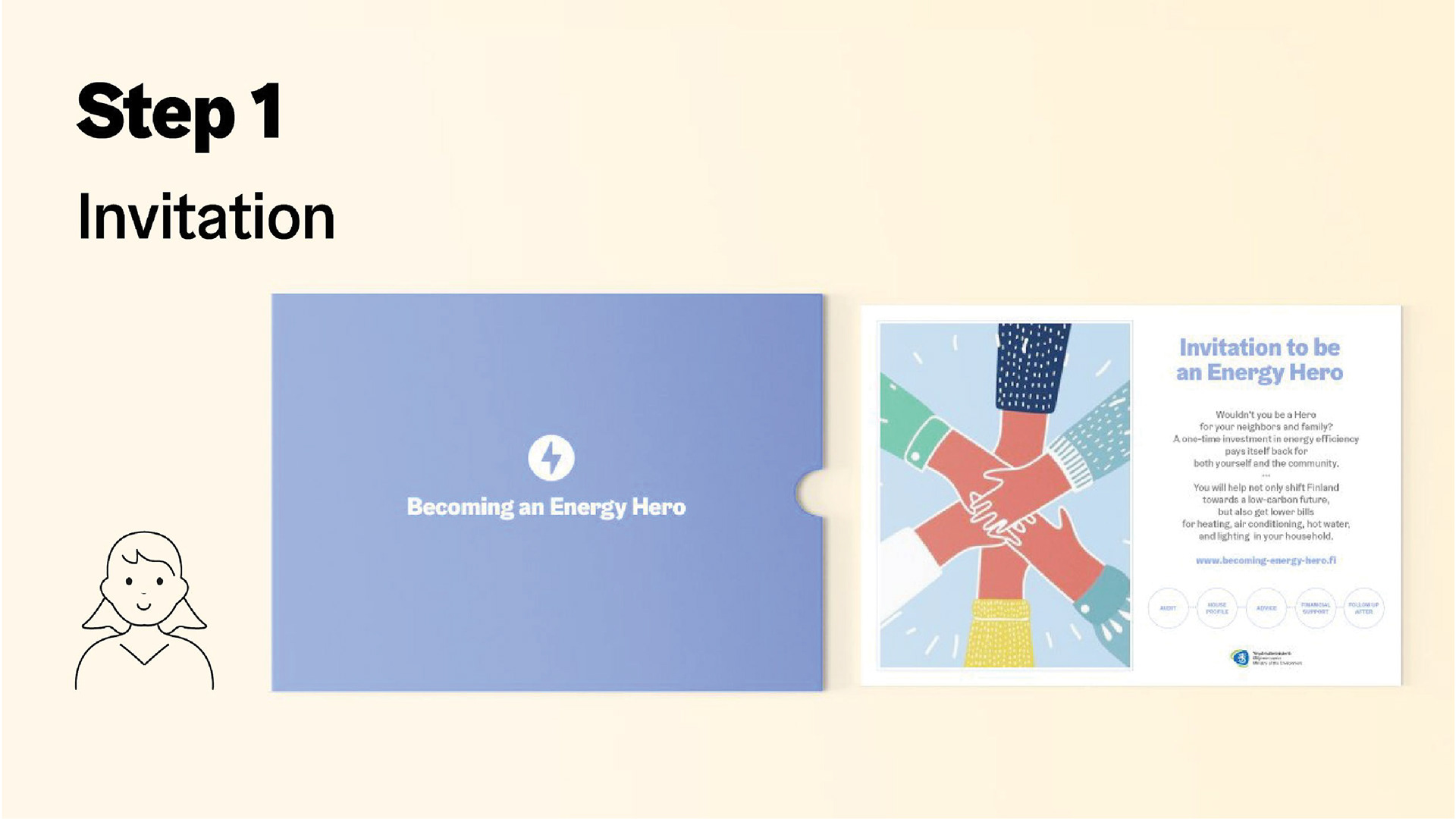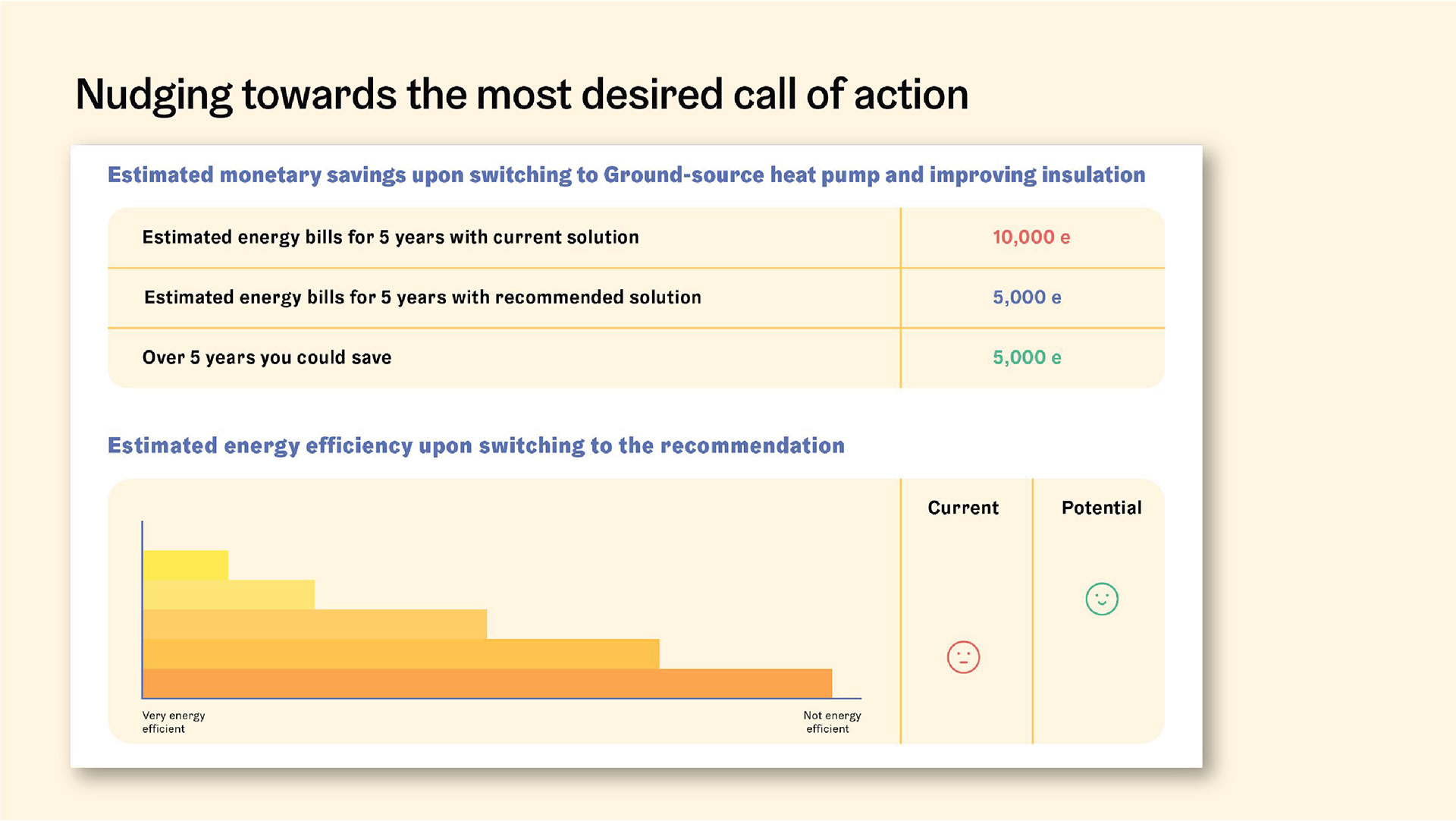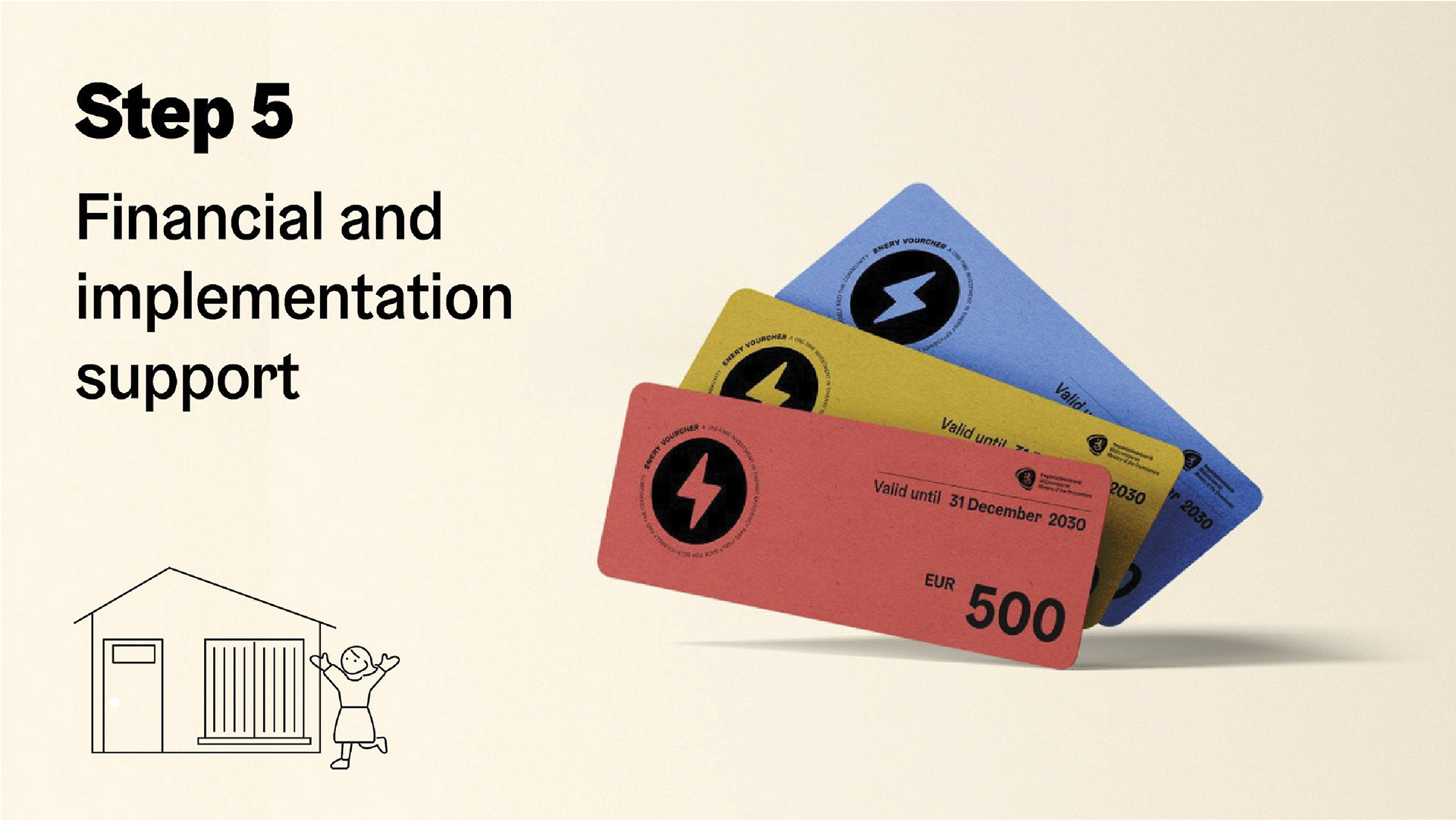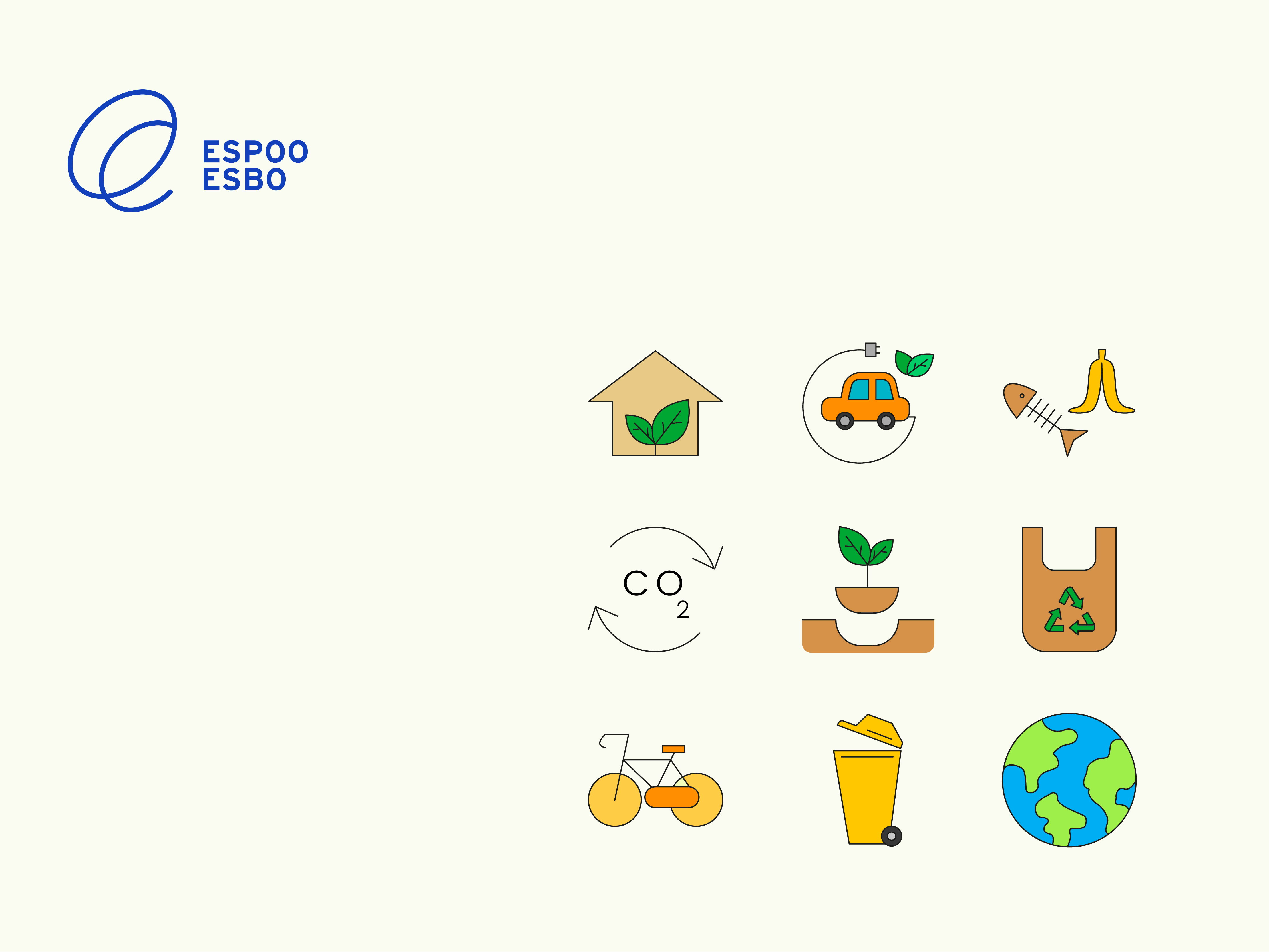A just transition to post-oil heating
The project was done as part of the Design for Government course at Aalto University.
Teammates: Ásta Ágústsdóttir, Sumi Mooni and Ville Pellinen
Tutors: Nuria Solsona, Ramia Mazé and Taneli Heinonen
Research methods: Survey, Expert interview and Desktop research
Conceptual framework: Behavioral change, Social Norms, Nudges and StorytellingMy role: Survey Development, Concept Development, Web Design, Illustrations, Final Presenattion Delivery
Duration: 4 months, 10 cr
Project background 🛢️ 🏠
Finland has an ambitious target to become carbon neutral by 2035. However, oil is still commonly used for central heating in single-family homes, and these account for 130,000 homes across the country.
Moving away from residential oil-heating is much more than a technical question of energy systems and substitutes. The Ministry of the Environment is assessing measures to ensure a fair and just transition in the matter. This requires knowledge and understanding of the citizens living in the oil-heated housing: what hinders the transition, what are the effective means and measures and how the state can now effectively support the transition?
This project looks at offering feasible and viable support to single-family homes in Finland, including regulation of their lifespans and residential lifestyles in order to reduce their CO2 emissions.
Solution Summary 📨 🥇
Our proposal is for the Government to initiate a regional pilot by providing customized solutions to the special needs of different user types. We want to encourage the transition by Boosting social norms and offering as much support as possible. Energy efficiency Improvements could be a part of the solution, including, but not being limited to, reducing or completely getting rid of using oil.
Based on our research, we believe that aiming at maximizing the energy-efficiency of oil heated houses is a just and natural milestone towards a complete post-oil heating transition and eventually, towards a carbon neutral society.
1. Research and Analysis
Our work towards developing a proposal for just a transition to post-oil heating in homes was organized into four different phases with different perspectives: human, systems, intervention and proposals.The human perspective was about generating a project plan and familiarizing oneself with and applying different human-centered qualitative research and design methods. The system perspective was about continuing the research work and applying systems thinking to the data and findings gathered through human-centered research and design and analyzing the data with the help of different systems maps as well as developing Insights based on the analysis. The intervention perspective was about identifying certain opportunity areas and feasible design drivers arising from the Insights developed as well as choosing behavioral design intervention types with good fit to the opportunity areas and design drivers. The proposals perspective was about formulating and Refining sharp proposals to the commissioned challenges based on the chosen types of intervention.
1A. The Human Perspective
Here, we familiarized ourselves with the Commissioners of the project as well as identifying other potential key stakeholders based on desk research conducted on the matter.
The most important research methods were:
1. Commissioners Workshop: During the workshop, the Commissioners introduced us to the challenge of just transitioning to post-oil heating in homes in more depth. Additionally, we co-designed initial Insights, assumptions and relevant research questions regarding the matter to help us direct our research and design work.
2. Expert interviews: The expert interviews were particularly crucial for understanding who would be the main stakeholders to take into account in the heating transition as well as for designing, what should be asked from the Residents during our Resident research in the Systems Perspective phase. The findings from the interviews are illustrated in figure 2.
Fig 1: Brainstorming and documenting in the commissioner workshop
Fig. 2: Mindmap produced by interviewing the experts
Fig 3: Stakeholder Map
1B. The System Perspective
When we moved to the second phase of our project, the systems perspective, we continued our research work and simultaneously, started analyzing the data gathered and applying systems thinking to it to form Meaningful Insights. One of the main goals of our analysis work was to reframe the general problem presented in the project brief and identify more specific and concrete sub-problems to address.
Our methods included:
1. Resident Questionnaire: The main body of our Resident research was formed by an extensive questionnaire sent to members of the Omakotiliitto - that is, people living in detached houses. The questionnaire was sent to about 45,000 email recipients of the Homeless Association and altogether, we received close to 3,800 answers of which almost 1,000 came from current oil-heaters, almost 800 from previous oil-heaters and almost 2,100 from Residents who do not have or have not had oil-heating in their house.
2. Systems Mapping: The data categorizing, mapping and visualization methods we mainly used were Affinity Diagramming, other systems maps and archetype creation. The main purpose of our systems mapping was to map out and connect different stakeholders' views, perceptions, ideas and influences regarding the post-oil heating transition. This enabled us to make sense of the data gathered and identify some patterns and potential leverage points, “places in the system where a small change could lead to a large shift in behavior” (Meadows & Wright, 2008, p.145), that could enable to drive the transition in a just and fair continent.
Fig. 4: Affinity Mapping
2. Research findings
2A. Key Findings
1. Finding from the Commissioners: Technology neutrality, and more broadly speaking market neutrality, was something we clearly needed to address in our proposal in one way or another.
2. Desk research finding: Many of the oil-heated houses are now certainly inhabited by rather elderly people, as it is fairly common that elderly people live in detached houses (Helminen et al., 2017). Also, the natural transition away from oil-heating seems to be somewhat faster than what the official statistics reveal as many of the heating renovations do not appear in the stastistics (Rouhiainen, 2018).
3. Questionnaire finding: Based on the extensive amount of Responses we received through the questionnaire, we were able to develop three different household archetypes based on their heating solution: 1) who currently have oil-heating in their house, 2) who have had oil-heating and 3) who have never had oil-heating in their current house. These archetypes serve the purpose of identifying how different detached households' situations differ in general. The statistics are depicted in figure 5.
Fig. 5: Chosen key figures regarding oil-heaters living in detached houses
2B. Key Insight
3. Intervention
When starting to formulate our proposal based on the ideation, we sought guidance from the different Styles of government interventions by Siodmok (2017), presented in figure 5. To help concretize and clarify a potential proposal, we tested it by making a three minute pitch and Validating it with our peers and teachers.
Selected intervention points:
1. Champion: Build a case for change and alliances for action
2. Grants and subsidies: Incentive behavior change through Grants and other other incentives.
3. Choice architecture: 'Nudging' behavior so that the default is both attractive and easy.
Fig 5: Styles of government intervention Source: (Siodmok, 2017).
4. Proposal
Our proposal is for the Government to initiate a regional pilot by providing customized solutions to the special needs of different user types. We want to encourage the transition by Boosting social norms and offering as much support as possible.
4 A. Aims of the proposal
In order for the proposal to be just, it aims and the essential principles are derived from the five design drivers - easiness, transparency, equality, flexibility and voluntariness.
Design drivers:
1. Easiness signifies accessibility and hassle-free conditions for the Residents. Both the solution and all communication surrounding it should be as easily available as possible, motivating the Residents to participate.
2. Transparency or clarity of the given information is Vital for building trust. For example, residents know their current situation and track their own transition path, so they can anticipate what benefits are included on an individual household level.
3. Equality of opportunity to transition and information sharing regardless of age, income, and residence type is required to have a sense of fairness. However, equality does not mean everything is always the same for everyone.
4. Flexibility plays an important role as 'one size does not fit all.' Each of the household situations is different, some might need a completely changed solution, and some might not.
5. Voluntariness, especially as the primary user group is from an older generation. This enables the Residents' to transition voluntarily, not from a top-down perspective.
Fig. 6 :Aims of the proposal
4 B. Proposal: Regional pilot
1. Invitation for Residents: In the Energy Hero journey, the municipalities and associations would first reach out to the Residents of the region via phone calls and personalized letters, whose content would be targeted especially for the current oil-heaters.
2. Auditing / self-Auditing: Once the Residents are on board, municipalities, together with for example Motiva, would perform the household-specific audits.
3. Set of proposed actions: Upon receiving the details of the households, the auditor would generate a house profile and suggest recommendations for the transition.
4. Financial and implementation support: Once that is done, the government would offer upfront financial and implementation support to undertake the transition and energy solution providers would then implement the quality-guaranteed energy-efficiency renovations.
5. Energy efficiency tracking: All the records would be kept online so that the progress could be tracked and compared.
6. Sharing success stories: And finally success stories could be shared to motivate other regions and households.

Overview of the journey

Role of stakeholders
Energy Hero: Journey to become an Energy Hero
Here is the summarized journey of becoming an energy Hero through the perspective of a Resident.
We have personified it though Vivi. She lives in a detached house in Salo with her husband. Her main source of income is a pension plan. Although she is aware of the impacts of oil usage on the environment, she is a bit hesitant to do the transition due to a lack of financial means and mixed information.

First, Vivi receives a letter and a call from her municipality or an association informing her about the pilot plan. The invitation includes an introduction to the initiative along with details of the online portal where she can find further information.

She then logs into the website and familiarises herself with the Energy Hero package by inputting her address.

Since Vivi is rather tech-savvy, she opts for the self-auditing process on the portal. She is asked to fill in information related to her dwelling type, number of occupants, heating supplier etc. Additionally, she is asked to attach important documents such as house ownership paper, energy bill of the previous years and details of the applicable financial means.

After she fills in the audit form, a ‘house profile’ is generated. It is carefully designed, offering a choice architecture to nudge Vivi to the most feasible and energy efficient alternative,

The first half of the house profile recommends her feasible energy-efficiency improvement options and prioritizes them according to their favorability.

The second half of the ‘house profile’ gives her details of the potential energy and cost savings if she takes the above recommended alternatives. She is also presented with a set of local, trustworthy energy solution providers that could provide her the preferred solutions.

Once Vivi has made her choice, she is presented with the financial support she might be entitled to. Some options are via compensation vouchers while others, incurring bigger expenses, are via a combination of vouchers and affordable loan schemes.

Once Vivi’s house has undergone the recommended transition, she has the option to track her own journey and compare it to her previous situation. If Vivi is feeling inspired to even further minimise her carbon footprint, she could request for further recommendations.

Vivi can for example see the development of her energy-use related carbon emissions and how much money she has saved in various heating related activities such as ‘cooking, house heating etc’.

Vivi could also compare her efficiency to others in the neighbourhood. Humans are competitive by nature . So, by gamifying the comparison, we are trying to promote healthy competition amongst neighbours to be the most energy efficient.

After one year of the transition, Vivi is approached by a representative from the municipality to share her experience of the EnergyHero pilot and help the ministry in sharing her feedback of the pilot. She is also asked if she would like to share her positive story in the media to motivate the change on a nationwide scale.

We have mapped out a timeline for the project to take place in. This includes an initial 6 months dedicated to starting the pilot, the most crucial points in this phase would be to identify the households using oil-heating within the selected region, choose motivated volunteers to take part in it and finally find ambassadors willing to share their experiences.
Reflections
‘Just transition to post-oil heating in homes’ is not just a technical matter but even first and foremost a social and financial matter with strong local and household level variation. This sort of early-stage realisation helped us in leveraging on a human-centred approach for systems change. At a personal level, the project has been quite substantial in the formation my understanding of how closely social sustainability and environmental sustainability are intertwined. The most valuable finding from the project has been the research finding for the client. But using a student team, the ministry was able to approach its citizen in a relatable manner. This experience made me feel like an empowered student to bring meaningful impact to the world.



